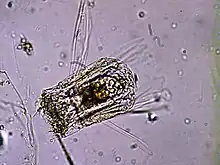Monogononta
Monogononta is a class of rotifers, found mostly in freshwater but also in soil and marine environments. They include both free-swimming and sessile forms. Monogononts generally have a reduced corona, and each individual has a single gonad, which gives the group its name. Males are generally smaller than females, and are produced only during certain times of the year, with females otherwise reproducing through parthenogenesis.
| Monogononta | |
|---|---|
 | |
| Polyarthra | |
| Scientific classification | |
| Domain: | Eukaryota |
| Kingdom: | Animalia |
| Phylum: | Rotifera |
| Superclass: | Eurotatoria |
| Class: | Monogononta Plate, 1889 |
| Orders[1] | |
Their mastax is not designed for grinding. They produce mictic and amictic eggs. The class contains 1,570 species.[2]
References
- Segers, Hendrik (2012). "Monogononta". WoRMS. World Register of Marine Species. Retrieved 2012-12-03.
- Segers, Hendrik (2007). Annotated checklist of the rotifers (Phylum Rotifera), with notes on nomenclature, taxonomy and distribution. Auckland, N.Z: Magnolia Press. ISBN 978-1-86977-130-0. OCLC 174102150.
This article is issued from Wikipedia. The text is licensed under Creative Commons - Attribution - Sharealike. Additional terms may apply for the media files.